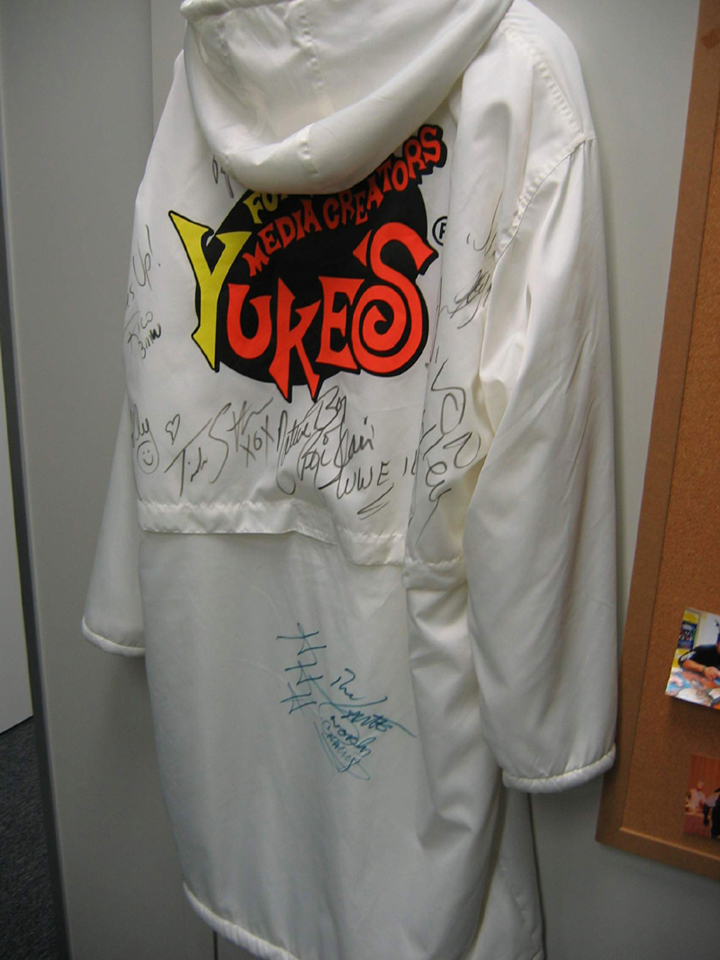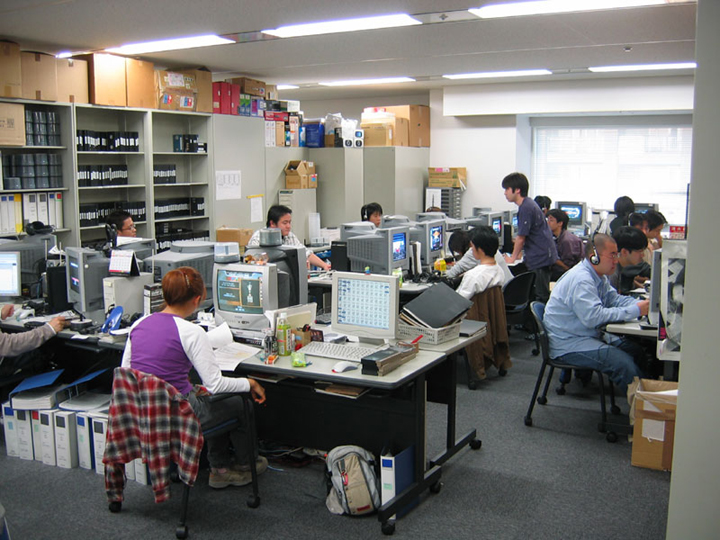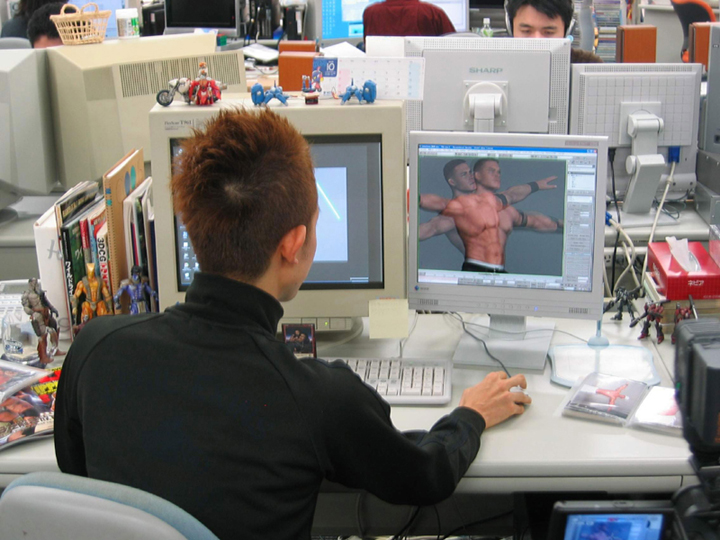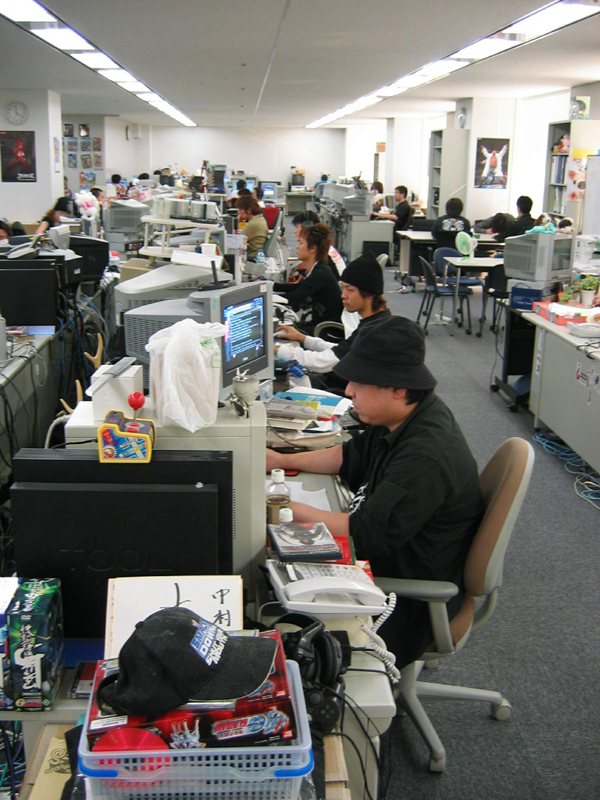Yukes Behind the Scenes
We go behind the scenes with the makers of SmackDown! vs. Raw 2006, straight from their Yokohama studio.
Design by Collin Oguro
When you think of the SmackDown! PS1 and PS2 games, there's one name that immediately comes to mind: Yuke's, the sole development house for the entire line of SmackDown! games that, with this year's SmackDown! vs. Raw 2006, has been around for five years and seven entries. Over the course of its 12-year history, Yuke's has built and maintained a reputation as one of the most highly respected game developers in the industry. That reputation has been built largely in the wrestling genre--a category that Yuke's has not only thrived at, but also has helped define since the very early days of the original PlayStation. Just in time for the release of its latest effort, SmackDown! vs. Raw 2006, we traveled to Yuke's Yokohama studio (just south of Tokyo) to get a behind-the-scenes peek at the company and the making of the game.
THE START
Yuke's was founded in 1993 by company president Yukinori Taniguchi. The company's name, Yuke's, came from a nickname Taniguchi's classmates gave him while he attended high school in the United States. The company's first game--a PlayStation platformer known as Hermie Hopperhead--was Yuke's first product and was programmed by Taniguchi himself. As SmackDown! series producer Hiromi Furuta explains, it wouldn't be long before Yuke's found its niche in the wrestling genre.
"At the same time we were making [Hermie Hopperhead], [SmackDown! vs. Raw 2006 general manager mode designer] Kenji Nakamura's older brother, who was a big fan of pro wrestling, was working on a pro-wrestling game and decided that pro-wrestling games should really be made in 3-D with polygon characters, instead of real simple 2-D characters. So that basically was the start of [Yuke's first wrestling game] Toukon Retsuden. The two games basically got done right about the same time, and those were our first two releases," Furuta said.
Of the two games, Toukon Retsuden was the clear winner with Japanese gamers. "I think just seeing 3-D polygon characters in a wrestling game had a very big impact on fans...so there was much more reaction to that, and [we] could see that there was a lot of potential in pursuing that avenue," Furuta said. "When we first made Toukon Retsuden, the response was very positive. So, it was published through Tomei, and they, of course, asked us to make a sequel. The first step was making the first pro-wrestling game and the next step was making the sequel to that and the following step was, of course, being another sequel to that, where it kind of changed [from] being just a sequel to being a series. That is about the time that we decided that pro wrestling was going to be a very big part of our future as a company."
The Toukon Retsuden series lasted for four entries and appeared on both the original PlayStation and the Dreamcast. A second Toukon franchise--Toukon Road--saw two entries on the Nintendo 64. As the games continued and the Yuke's team kept honing their wrestling engine, the team's wrestling-game design philosophy coalesced into three major areas: striking, grappling, and submissions. As SmackDown! vs. Raw 2006 season-mode director Yoshio Togiya explained, this trio came about in a natural progression.
"The original trio of fundamental elements of the game--striking, grappling, submission--those originally came about with Toukon Retsuden," Togiya said. "The original concept was basically a 'rock-paper-scissors' approach to gameplay. There were three basic things you could do; each of them was superior to one of the others and inferior to one of the others. So basically, what [we] wanted to do was take pro-wrestling elements [and] put it into a very well-known, simple game mechanic like the rock-paper-scissors setup, so it would be easier for people to get into and understand that basic part of the gameplay."

It wouldn't be long before a fourth element came into play in the Yuke's wrestling approach--the reversal system introduced for the first time in the original Toukon Road. "In pro wrestling, a big part of the ebb and flow of a match is the fact that there are turnarounds, and the momentum changes; things turn around and come the opposite way," Togiya said. "So once we had the basic rock-paper-scissors thing working, you could see that we needed some kind of turnaround mechanism. At least in the Japanese version of rock-paper-scissors we have something called aiko, which is when people pick the same thing, the game kind of continues off in a different direction. So, similar to how that works in the rock-paper-scissors game, we felt we needed to add in the whole concept of reversal--not just in the move sense, but reversal of fortune. We needed some mechanism for that to better reflect the way a real pro-wrestling match goes."
So, with all the gameplay elements in place, how did a small Japanese game studio become the sole developer of WWE games all over the world? Furthermore, what role did one of the company's strongest rivals have to play in making this happen? The answers are on the next page.
YUKE'S TODAY
The relationship between Yuke's and publisher THQ (and thus the WWF) came about at the behest of THQ president Brian Farrell, according to Furuta. Farrell and Yuke's president, Yukinori Taniguchi, met at E3, where Farrell asked if Yuke's would be interested in making a wrestling game for the publisher. As it turned out, the recommendation for Farrell had come from one of Yuke's biggest competitors: Aki (developers of WWF games such as No Mercy). "This is something I did not hear until later," Furuta said, "but originally, apparently the president of Aki had talked to Brian and said, 'Well, if you're looking for someone to make your wrestling game for PlayStation, maybe you should talk to Yuke's.' So we've always been thankful for that introduction from the president of Aki."
Furuta said the SmackDown! series came to Yuke's at just the right moment, at a time when the popularity of Japanese wrestling was waning and when American wrestling--and in particular the WWF--had never been hotter. "At that time, most of the staff was very familiar with Japanese pro wrestling and looked at the WWF as a really different kind of entertainment, more focused on the entertainment aspect than the wrestling aspect," Furuta said. "[The team was] very worried about how to approach it and if they could do a good job of it. [Wrestling supervisor Toshihiko] Kitazawa-san, one of the lead designers, was a WWF fan at the time, a very big fan. He became kind of an evangelist within the team, showing people how entertaining the WWF was; he had a big collection of videos that he would show to people and explain to people the different kind of entertainment the WWF was. As people began to look and understand what the WWF was all about, they realized that, compared to Japanese wrestling, this was a lot easier of a world to make a game about."
That Aki had a hand in helping Yuke's become the sole developer of WWE console games is one of the ironies of business in Japan, it seems. The relationship between the two companies, in typical Japanese fashion, has simultaneously been one of fierce competition and healthy respect. When asked about her thoughts on the sometimes seesaw battle between the two companies, Furuta responds quickly with a healthy admiration for the company.
"We have a long history with Aki and we have a lot of respect for them as a company and what they've done as developers," Furuta said. "Currently, Aki is not making pro-wrestling games--they've recently been doing the Def Jam games. Since they stopped making pro-wrestling games--WWE-type games that are considered direct competitors to us--that competition has gone away.
"Back when Aki was making No Mercy, it was a very exciting time. The staff here felt under a lot of pressure to match or surpass everything that Aki did. Whenever new information would come in, Yuke's and THQ would be jumping up and down about 'Aki's going to do this! We have to do it! We have to do it! We have to top that!' paying no real heed to schedule or practical issues, just thinking, 'We have to beat them! We have to beat them!' So it was a very exciting, tense time of rivalry."
In trying to keep that spirit of rivalry alive in the company, the Yuke's development team is split among two separate studios. The Yokohama team is responsible for the SmackDown! line of games, while a separate office based in Osaka has been developing the Day of Reckoning series on the GameCube. As Furuta told us, the two divisions strive to top one another with each new product release, going so far as to even view one another as friendly rivals.

"During development we talk very little in terms of sharing ideas and we try to compete with each other in terms of making a good game," Furuta said. "We do share things like art assets and, of course, any information that comes from THQ about the WWE or other materials like that, but in terms of the actual content of the games, we make two separate games and try to maintain a competitive relationship."
But what about sharing game concepts--could the SmackDown! team borrow Day of Reckoning 2's inventive submission system? Does the Osaka team have the ability to borrow and improve upon SmackDown! vs. Raw 2006's general manager mode? Furuta responds: "When the games are done, both teams look at each other's games and kind of compare what was done well, what wasn't done well, and get some ideas from that. Also, we may get requests from THQ saying, for example, 'Oh, we really liked the way this was done in DOR this year, can you do something like that for SmackDown!?' Although [we] don't like to admit to using each other's ideas, it does happen."
Room for Improvement
The Yuke's SmackDown! wrestling engine--long known for its speed and flexibility--has been honed over many years and many different games, with improvements coming as each new game has been released. This year's SmackDown! vs. Raw 2006, for example, includes a stamina system (one borrowed and altered slightly from stamina systems found in Japanese games such as Fire Pro and King of Coliseum, as well as the Yuke's own Day of Reckoning 2) that adds another layer of complexity to the overall action in the ring. How do Yuke's developers rate the latest iteration of the company's SmackDown! wrestling engine? It depends on whom you ask.
On a scale of one to 10, SmackDown! vs. Raw 2006 director Taku Chihaya rates the engine a nine. "So on the good side, I think that we have a lot of pride in our wrestling engine," Chihaya said. "It's an engine that's been developed over a long time specifically for wrestling, not for any other kind of general-purpose engine or anything. So we think, in that respect, we've done a very good job with it and it's the best wrestling game engine out there. The reason I give it a nine instead of a 10 is that I still think there are some areas of pro wrestling that we could reproduce a little better than we do now, particularly that kind of fine line between what's real and what's show business and kind of helping the user enjoy that...[as] part of the WWE experience."

Main game designer Kentaro Arai is slightly less generous with his rating. "I give it a seven," he said. "I think that the engine is very good in terms of representing the overall pro-wrestling experience, kind of in the broad sense of a pro-wrestling engine. I think what we could improve on is getting more into the specific details of the WWE itself, and the WWE experience, as opposed to the general pro-wrestling experience. So I think we can improve a fair bit there. And also, just in general, I think there's always room for improvement in any engine and I'd like to continue making the game better every year."
Of course, beyond the Yuke's crew themselves, there's no tougher critic on wrestling games than wrestling fans, who are obsessively detailed in their assessments of Yuke's games. "Compared to other sports games, we find that pro-wrestling game fans are very dedicated to their games and they pay very close attention to small details," said Chihaya. "On the one hand, they can be very critical about very small things. For example, The Undertaker's entrance is too short or too long. At the same time, that means they look at the game very closely and they take it very seriously and so they come up with ideas that very often are good ideas. Because the fans are so dedicated to the game, we do like to keep up with what the fan requests are and try to make changes that the fans want to see. We kind of look at it as a contest between the designers and the fans to see if the designers can keep up with making a game good enough to keep these very serious, strict fans happy with the quality of the game."
Perhaps the biggest new feature in SmackDown! vs. Raw 2006 is the general manager mode, which puts you in the shoes of a WWE GM and lets you book a year's worth of shows for either Raw or SmackDown! with the ultimate aim of drawing more fans than your rival promotion. It's a mode that fans have been clamoring for for years now. But what of future iterations in the series? What kind of things are fans asking for that the team hopes to implement? "This year we added a 'hardcore' attribute to the wrestlers' attributes and noticed that once the information became publicly available there was a lot of reaction on the Internet--people having ideas about, 'What does hardcore mean?'" said Kentaro Arai. "A lot of ideas came up from the user community on that, and we have been looking at all those... That has kind of inspired within our design team a lot of ideas as well--to really expand out on what the hardcore attribute can mean in matches, and how that can make matches a lot more exciting."
THE FUTURE
Over the years, Yuke's bread and butter has been wrestling games--along with the SmackDown!, Day of Reckoning series, and its Japanese wrestling titles, the company has developed a pair of WrestleMania games for the GameCube as well as the Rumble Roses series for PS2 and the upcoming Xbox 360. There's every reason to believe the developer will continue to find success in this genre for many years to come. That has not stopped Yuke's from branching out into other gaming genres. Games like Eve of Extinction and Sword of the Berserk: Guts' Rage are just two examples of Yuke's stretching a bit into the action genre. The company even has a few racing games to its credit--Edit Racing for the PS2 (which featured a Monster Rancher-like track generator that would spawn random courses from music CDs or DVDs) and the recently-released D1 Grand Prix Series 2005.

When asked what genres the company hopes to attempt in the future, the answer isn't entirely unexpected: role-playing games, one of Japan's most popular gaming genres. In fact, according to Furuta, Taku Chihaya, SmackDown! series director, has said that before he retires he wants to make at least one RPG.
While there's no word on when a Yuke's RPG might happen, we do know that the company is always looking ahead and trying to focus on what kind of technological and design trends will shape the future of gaming. A big part of that package will be online play, especially for wrestling games. Several Yuke's developers told us they envision a day in the not-too-distant future that 30-man Royal Rumbles will be playable by 30 separate individuals online, a prospect that sounds both maddening and fascinating at once. For her part, when asked about the future, Furuta takes a more general approach.
"I think that in the near future, games will be making a transition from a packaged product that you buy out of the box to something that really exists online," she said. "Other things...that we think will expand online are having some kind of story or season mode [that's] almost like an online RPG, where a larger number of people can all interact in the same story and the same world. So that's an area where we think there will be a lot of growth in the future; it might not be in the next two or three years, it might be [in the] longer term...but that's one of the major directions we think the future of wrestling games will be going in."
As exciting as this kind of future for wrestling games sounds, it's nice to know that a company of such talented and dedicated individuals will be leading the charge into the next generation of wrestling games and beyond. We'd like to thank the entire Yuke's staff for their enthusiasm and generosity during our visit to their studio.
Got a news tip or want to contact us directly? Email news@gamespot.com

Join the conversation